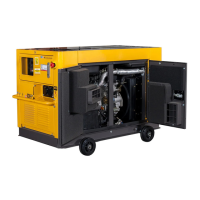
Do you have a question about the Kipor KDE11SS and is the answer not in the manual?
Welcomes the user and stresses the importance of reading the manual for safety.
Explains safety labels (DANGER, WARNING, CAUTION) and operator responsibilities.
Covers duties, handling abnormalities, and avoiding mechanical/electrical risks.
Details risks related to electricity, grounding, and flammable materials.
Warns about hot parts, radiators, and battery handling safety.
Addresses noise, safe cable connections, and maintenance precautions.
Outlines the generator's application, legal adherence, and professional operation requirements.
Identifies external components for various generator models through diagrams.
Illustrates and labels the internal components of the generator for understanding.
Guidelines for generator placement, ventilation, and ground conditions.
Advice on storing the unit and managing noise during operation.
Safe practices for lifting, securing, and moving the generator.
Methods for calculating generator capacity based on motor input power.
Procedures for properly grounding the generator and connected equipment.
Details on connecting loads using three-phase terminals and single-phase receptacles.
Guidance on choosing appropriate cables and ensuring safe load connections.
Recommends fuel types and describes safe fueling procedures.
Guidance on selecting lubricants and managing cooling water quality.
Essential safety measures and steps for battery charging and maintenance.
Steps for filling fuel, oil, and coolant, and performing initial checks.
Procedures for starting, testing, and adjusting frequency and voltage.
Guidelines for operating under load and safely shutting down the generator.
Importance of periodic checks and safety during maintenance activities.
Detailed maintenance items scheduled for 50, 250, 500, and 1000 hours.
Detailed steps for initial and periodic maintenance tasks.
Addresses engine starting issues, voltage problems, and other common faults.
Explains how environmental factors affect generator power output.
Lists detailed specifications for single and three-phase generator models.